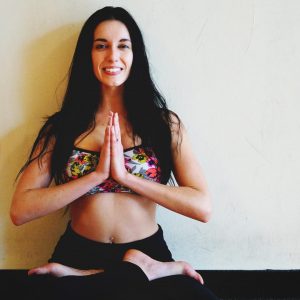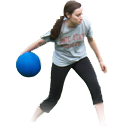
10 Words to Know So You’re Not So Confused in Yoga Class
Starting a yoga practice is daunting enough without being befuddled by the yoga lingo coming out of your teacher’s mouth. Many teachers use terms derived from the classical language of yoga called Sanskrit; they may or may not follow these with the English translation, so it’s helpful to learn the most common yoga words you’re likely to hear. Once you’ve got the basics down, you won’t feel so lost during your next practice.
1. Asana: Posture or Pose
In traditional yoga, asana — the physical postures — is only one part of the yoga practice. In Western classes, it tends to make up the majority of practice. Physical postures can include anything from Tadasana, or Mountain Pose, to Sirsasana, or Headstand. Savasana — Corpse Pose, or final resting posture, is also asana.
Traditionally, the practice of these physical postures was meant to calm the mind, purify the body and provide physical strength and stamina for meditation. These days, asana is also performed as a workout or as a moving meditation.
2. Pranayama Breathing Techniques
In yoga, the breath, or “prana,” is thought to be a person’s life force. “Ayama” means to extend or draw out; together the two words mean breath control. Pranayama can be used to build heat, or energy, in the body, and it can be used to cleanse and calm the body and nervous system.
The most common type of pranayama used in classes today is “Ujjayi” pranayama, also variously referred to as Victorious, Ocean and Conqueror Breath. Ujjayi is a strong breathing technique in which you constrict the back of your throat and exhale as if you’re trying to fog up a mirror with your mouth closed. Inhales are slow and slightly audible.
Ujjayi pranayama is both energizing and relaxing. In a vigorous practice, it can be used to control the pulse rate for stamina, or it can be used anytime you need to feel calm and centered. Other types of pranayama include Kapalabhati, or Skull Shining Breath; Kumbhaka, or Breath Retention; and Surya/Chandra Bhedana, or Single Nostril Breath.
3. Vinyasa: Movement and Breath
The yoga term “vinyasa” has a few different meanings, but they all relate to the connection of movement and breath. In the vinyasa style of yoga, you flow from pose to pose through a sequence, the pacing of which relies heavily on pacing the breath. You inhale with certain poses and exhale with certain poses. Most teachers provide verbal cues for linking breath and movement.
You may also hear your teacher say, “Take a vinyasa.” This is the sequence of postures repeated frequently in vinyasa flow classes that involves a combination of Uttanasana (Standing Forward Fold), followed by Chaturanga (Four-Limbed Staff Pose), Urdhva Mukha Svanasana (Upward-Facing Dog) and Adho Mukha Svanasana (Downward-Facing Dog).
Styles of yoga that classify as vinyasa include Power yoga, Baptiste yoga, Ashtanga, Jivamukti, and Prana Flow.
4. Drishti or Focus
Drishti is yet another way of focusing the mind during a yoga practice. You might hear your teacher say, “Find your Drishti”; this means find a spot and focus your gaze there so your eyes aren’t wandering around the room. Not only does this keep you focused on your own practice instead of checking out your neighbor’s yoga pants, but it can also help your balance.
Drishti is a soft gaze. If you choose an image on the wall, for example, you shouldn’t look at it so directly that you can see exactly what is in the picture. On the contrary, the gaze should be slightly fuzzy. Some poses, especially in practices such as Ashtanga, have their own Drishti points. For example, in an Ashtanga practice when performing Seated Forward Fold, the Drishti point is the toes.
5. Surya Namaskar Sequence
Surya Namaskar, or Sun Salutation, is one of the most common sequences in yoga. This dynamic sequence is usually performed at the beginning of a practice to warm up the body and prepare it for the asana to follow. There are three main types of Sun Salutation — A, B and C — each including a different set of postures.
Sun Salutation A includes the following sequence:
- Tadasana (Mountain Pose)
- Urdhva Tadasana (Upward Salute)
- Uttanasana (Standing Forward Fold)
- Ardha Uttanasana (Half Standing Forward Fold)
- Chaturanga Dandasana (Four-Limbed Staff Pose)
- Urdhva Mukha Svanasana (Upward-Facing Dog)
- Adho Mukha Svanasana (Downward-Facing Dog)
- Ardha Uttanasana
- Uttanasana
- Urdhva Tadasana
- Tadasana
- Tadasana
- Utkatasana (Chair Pose)
- Uttanasana
- Ardha Uttanasana
- Chaturanga Dandasana
- Urdhva Mukha Svanasana
- Adho Mukha Svanasana
- Virabhadrasana I (Warrior I) right side
- Chaturanga Dandasana
- Urdhva Mukha Svanasana
- Adho Mukha Svanasana
- Virabhadrasana I left side
- Chaturanga Dandasana
- Urdhva Mukha Svanasana
- Adho Mukha Svanasana
- Ardha Uttanasana
- Uttanasana
- Utkatasana
- Tadasana
Sun Salutation C (performed left and right sides):
- Tadasana
- Urdhva Tadasana
- Uttanasana
- Ardha Uttanasana
- Backward lunge right side
- Chaturanga Dandasana
- Urdhva Mukha Svanasana
- Adho Mukha Svanasana
- Forward lunge right side
- Ardha Uttanasana
- Uttanasana
- Tadasana
6. Intensifying Energy with Bandhas
Bandhas are internal yoga locks meant to supercharge your practice. With a bandha, you close off, lift up or draw in at particular points on the body to direct energy in the body. In addition to stimulating energy, people believe performing bandhas during practice cleanse energy channels, tone the organs, improve digestion and concentration, relieve depression and prepare the mind for meditation.
There are several types of bandhas, including:
Jalandhara Bandha: This is a throat lock that restricts the upward flow of energy most often used with breath-retention exercises. To do it, you press your chin into your upper chest.
Mula Bandha: Otherwise known as root lock, Mula Bandha focuses on generating energy in the core, or center of the body. To do it, you contract the pelvic floor, pulling it in and up.
Uddiyana Bandha: In this stomach lock, you expel your breath and draw the abdominal wall in and up to produce a hollowing beneath the rib cage. You hold your breath until you release the lock.
7. Chakras, Centers of Energy
The Sanskrit term Chakra means “wheel” or “disk.” As such, chakras are visualized as spinning wheels of energy and light. There are seven chakras, or energy centers, throughout the body: at the heart, throat, crown, forehead, base of the spine, lower abdomen and solar plexus.
Each chakra controls different aspects of energy in your body. For example, the third chakra is the source of personal power and the sixth chakra is the center of intuition. If a chakra becomes blocked, energy surrounding the particular chakra stagnates, disrupting physical, emotional, psychological and spiritual states of being. Yoga is one way to keep energy flowing through the chakras, and some teachers may refer to specific chakras during class.
8. Namaste
Usually said at the end of class, Namaste is an expression of respect in Sanskrit. Peopl usually utter it with the hands pressed together in prayer and with a slight bow of the head and upper body. At the end of a yoga class, students and teachers often use this word to thank each other for the time spent together, for showing up and for adding positive energy to the class.
The teacher might repeat the most common translation, which is, “The divine light in me bows to the divine light within you.” Like many Sanskrit words, namaste has multiple translations, but all of them amount to the same basic idea: We are one.
9. Savasana
Also called “Corpse Pose,” Savasana is the final resting posture. This is a place of complete relaxation, during which your body processes the work that you have just done during the active portion of class. It might surprise you to find out that the Savasana is a posture just like any other, and there is a correct way of doing it.
In the proper position, you are supine, with your arms extended alongside your body and your palms facing up. Your legs should be in a slight V with your feet allowed to fall out. It’s important to retain a neutral, relaxed position, but there are several steps to take to achieve this:
- Lift the pelvis and tilt it back toward your tailbone. Then release the pelvis to the floor.
- Inhale and extend the right, then the left leg, pushing through the heels. Then relax both legs, softening the groin.
- With your hands, grasp the back of the skull. Pull the base of the skull so that the back of your neck lengthens, then release your head to the floor.
- Broaden your back ribs, separating your shoulder blades, then release your arms to the mat.
- Allow your tongue, eyes, nostrils and the skin of your forehead to relax.
Although many students look forward to this pose, other students may find it difficult because it requires complete stillness, physically and mentally. Part of the practice is to quiet your mind of thoughts of the past and future. Although it’s tempting to think about what you’re going to eat for dinner, try to remain present and allow thoughts to simply float by without focusing on anything in particular.
10. Om
Some classes include chanting of a mantra, a sound meant to concentrate energy and focus. One simple Sanskrit syllable, Om, is one of those mantras. When you chant Om, or Aum, as it is also spelled, you are actually making three different sounds, “awe,” “oo” and “mmm.” The different sounds reflect the creation of the universe, the energy of the universe and the connectedness of the universe.
Although it can be challenging at first, the main goal is to feel the vibration in your body. It is not important how it sounds. Everyone chants differently. Just focus on the meaning and energy in the Om, and notice the feeling of synchronicity in the room during the mantra.
By Jody Braverman
The Arena District Athletic Club is more than just a gym, it’s a premier fitness facility located in the heart of the Arena District in downtown Columbus. We provide convenience and quality, featuring top-of-the-line equipment, top-notch personal trainers, spa-like locker rooms and a wide variety of free group fitness classes daily including Cardio, Spinning, Barre Fusion, Yoga, Boot Camp and more. We offer free 2-hour parking and convenient contract-free memberships, to fit your healthy lifestyle needs. Don’t just join, belong.





